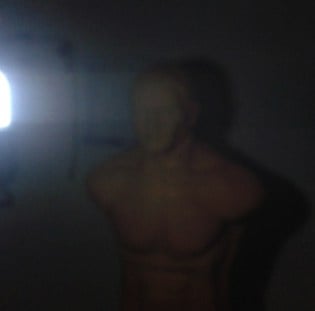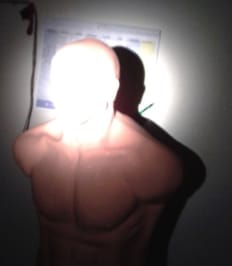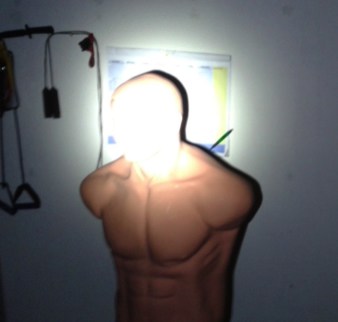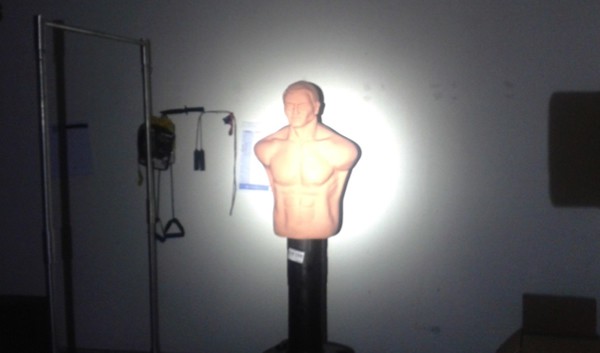As humans, we’re extremely visual creatures, and our reliance on our eyesight is one of the defining characteristics of the human experience. We define beauty, horror, entertainment, and boredom largely by visual stimulus. We are appealed to and motivated by our visual input, and perhaps most importantly, we base how we move almost entirely by sight, whether on legs, wheels, water, or in the air.
Vision is the sense that we prefer the most, and it is arguably the most validating of all our senses.
The dark is one of the first things young humans take issue with, and it has been the subject of innumerable horror stories. The helplessness we feel in the dark gradually fades as we get older and grow more confident that there’s nothing lurking just a half-step behind us. While the focus of this article isn’t the spooky, unexplained, or supernatural, there are plenty of threats held by the dark; their domain is the night, and during times of disaster and emergency.
The purpose of this article is twofold:
- To identify the situations in which we will need to provide light for safety
- To give basic instructions on how to use light to your advantage without jeopardizing yourself
Light and the Human Eye
The human uses rods and cones to detect the strength and the color wavelength, so in order to be visible, an object must either radiate energy itself (such as the sun, a fire, or a flashlight), or reflect particles – the size of these particles reflect certain wavelengths, which define color.
For the purposes of this article, we’re going to define how light is cast and measured using three terms that are generally used to describe flashlights:
- Throw: The distance that the light generated will travel and reflect off distant particles.
- Splash: The degree in which the beam will broaden over the thrown distance.
- Lumen: A a measure of the light emitted and interpreted by the eye. Most basic flashlights are around 60 lumens, which is generally the threshold at which you can temporarily blind someone.
Most ambient lights have very little throw but generate ‘splash’ lighting, which is gentle and not obnoxious. Flashlights – especially of the variety used by soldiers and police officers – are intended to generate more “throw,” which can be overpowering to the eye.
It’s important to mention that *both* types of lighting can be detected from a great distance away at night. While the curve of the earth prohibits us from viewing much beyond ~3 miles (i.e., the distance at which the curve of the earth begins to obscure distant objects), scientists have suggested that the human eye would be able to see a candle at as far as 30 miles. This makes sense, as on a clear night, you can look up and view galaxies that are literally trillions of miles away.
But, enough “gee whiz”; let’s get back to what this means to us.
Meet the Lights
The lights I’ll be using for this article are:
1. 4Sevens QT2L
2. Surefire G2 (stock)
3. Surefire Z2 Centurion with Malkoff M61L Lamp
4. GoalZero Chubby
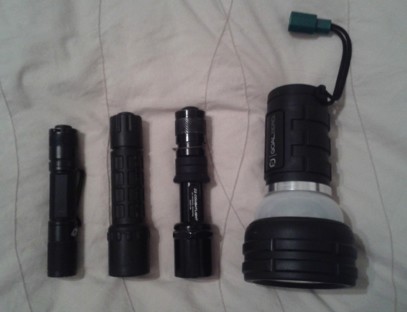
For the purpose of the article, it’s important to mention that all my lights have been upgraded using Oveready.com’s 17670 batteries, which offer a dramatically improved battery life over standard CR123 batteries and, perhaps most importantly, are fully rechargeable. I recharge these batteries from alternate, sustainable energy and am comforted by the knowledge that in an emergency, I’ll be able to recharge my lights, rather than be forced to find, stock, or trade for batteries.
40 Lumens, Ambient, 1 meter distance:
This is with a ‘lantern flashlight’, a GoalZero Chubby, which produces 40 lumens of lighting. In this picture, the lantern is 3’ from the target. You can see that the light is not producing a directional corona. This light is entirely ‘splash’ lighting – that is to say, it’s not ‘directional’ – and it radiates ‘evenly’ outward from the light source.
60 Lumens, Directional, 1 meter distance:
This picture depicts a 60 lumen Surefire Z2 from the same distance, 3 feet. You can see that there is a corona around the “thrown” light that covers the head and neck, and then “splashed” light on the wall behind the target. At this distance, the light is bright enough that it is difficult to make out the face of the target – on the receiving end, it is overwhelming.
However, by increasing the distance, we will see different results. It’s important to note that at this distance, your chances of an altercation are high, and being able to focus a light and its effective use will be dramatically diminished.
60 Lumens, Directional, 3 meters:
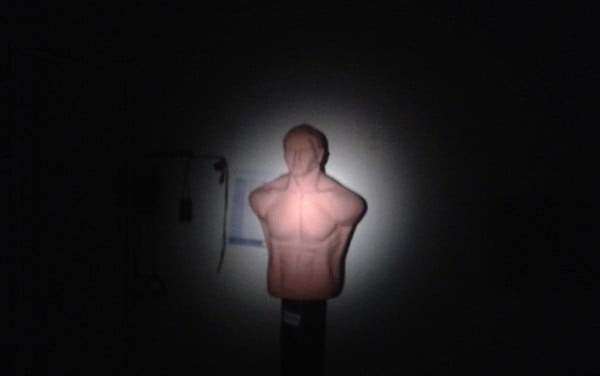
Here we see the same light (Surefire Z2) from a range of 3 meters, or 9 feet. The “splash” characteristics have almost entirely gone, and we see that this light is very directional. At 60 lumens, it doesn’t radiate outward far enough to cause much, if any, illumination on the periphery of the beam.
To illustrate the splash effect, try to identify the things you ‘see’ in the background. Keep them in mind, and let’s press on.
240 Lumens, Splash/Throw lamp, 1 meter distance:
This picture was taken is using 4Sevens QuarkQT2L flashlight.
As you can see here, the background is bathed in light – this is a much higher intensity lamp that is designed to have throw (again, note the corona) and splash. You can start to make out objects in the background a little more clearly
The light is still washing out the target’s face, and this is a very punishing light – if you are on the receiving end, but again, it’s important to avoid getting this close to someone you suspect may be up to no good.
240 Lumens, Splash/Throw lamp, 3 meter distance:
As you can see, this light has splash lighting that allows you to discern other things within your foveal (forward looking) vision. The beam has broadened to the entire torso, and the corona extends beyond the target – this is still very hard on the eyes from the receiving end – and notice that the features are still washed out. Compare the background to the 60 lumen picture, and you’ll notice you can see more clearly what is in the background – an important feature when you’re scanning in the dark.
Note on high-lumen lamps:
At this point, the impressive performance of the higher output lamps might make you think Why would I get a lower lumen lamp?
Keep in mind that these high-output devices will have a much greater signature and will make you visible to others from farther away. If your concern is not security, then higher output can also burn through your batteries faster, as well as heat up. You’ll have to balance your needs with performance, battery life, and desired use.
Lights as a weapon
Lights can be used as a weapon in two ways: It can be used to interrupt an attacker’s visual acuity and overload their vision with high intensity light, and/or be employed as an impact weapon (which means exactly what it sounds like – thump their gourd with it). However, one must take into account the purpose, durability, and suitability of their light to perform these tasks. If you’re walking around with a solar or hand powered flash light, chances are that if you hit something with it, the broken plastic will hurt you worse than anyone else. On the other end of the spectrum, there are things like this...
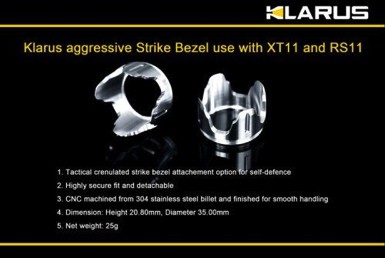
,,,which effectively turns your flashlight into a very small shark, which you can attach to your arm, but crenelated bezels (the spiky ones, for people who’re not into gear) can also be painful to carry. For this reason, I don’t use them, as I pocket-carry or use a small pouch for my EDC light, and I want both my pockets and pouch to last.
In addition, the effects of the lamp itself can be very disorienting. The strobe feature further adds disorientation to the temporarily blinding effects of stronger lights by continuously hammering the target with alternating light and darkness, which confuses the transmission of the molecule “rhodopsin” between the rods, which allow the rods of the eye to detect ambient light in dark conditions, and the cones. When the molecule breaks into retinol and opsin in light conditions, the cones of the eye take over. If the light is quickly turned out, the retinol and opsin are forced to recombine in the rods (since the cones are responsible for color vision and visual acuity) into rhodopsin, which allows the rods to detect the intensity of light.
This is what accounts for the “night blindness” that occurs temporarily once a light is turned out. Strobe disrupts this process, and has been shown by Ken Good to cause spatial disorientation and loss of balance in use of force situations (all credit for this to Mr. Good, and Strategos Int’l).
Concerns
Light in an emergency is an obvious conundrum. It allows you to see, but it also telegraphs a signature to anyone in the area and is (generally) readily identifiable as a man-made source of illumination. This may not be a concern (or it may even be a benefit), so we’re going to talk about two “base” scenarios in which we could find ourselves and in which we would use drastically different procedures.
SITUATION 1: Maximum Signature
In this type of situation, we are not in the least concerned with trying to keep our lighting to a minimum. That is to say, situations in which you are expecting extraction or rescue, or in which being noticed is a good thing. Situations in this category may be something as simple as a car accident at night, or as complex as a collapsed building after an earthquake. In these events, the light you make is produced to be a signal to anyone who may be nearby and able to help, and the only reason to keep your light use to a minimum is to conserve your batteries.
SITUATION 2: Low Signature
These are the situations in which demonstrating that you have the ability to create light would target you in some way. Perhaps as simple as a power outage during a very tense, resource-scarce situation (such as Superstorm Sandy), or maybe something more serious, such as awakening to a break-i,n or entering a building that potentially has an active shooter or other hostile parties inside.
In these situations, light signals your presence and orients the *wrong* kind of people to your ‘making the scene’. Since Situation 1 requires no special considerations, we will focus the next article on Low Signature light use, and break it down into categories that are more manageable, tactical, and security considerations.
Please join me as we continue to Use of Light, Part II, in which we will cover: grip and posture when using lights, using lights in tactical (Type I/II Emergencies) and strategic (Type III) Emergency scenarios, and using lights with weapons.
Cheers,
~ Aaron Moyer
Special thanks to:
Mark Jones (ACPS: http://www.acpsllc.com/)
Ken Good (Strategos International: http://www.strategosintl.com/)
Overready.com, and Joshua Astrella
This is a companion discussion topic for the original entry at https://peakprosperity.com/use-of-light-part-i/
